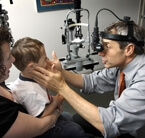
The one-week-old baby girl in Michael Repka’s office is proof that eye disease doesn’t discriminate by age. Diagnosed at birth with congenital cataracts, the young patient will likely undergo surgery with gen¬eral anesthesia at three weeks of age. If not promptly treated, the child could suffer permanent vision loss.
“It’s a bit of a shock for parents,” says Repka, a pediatric ophthalmologist at The Wilmer Eye Institute at Johns Hopkins who sees a new case of congenital cataracts approximately every two weeks. “When you go home from the hospital with your first child, this isn’t what you expect. And it’s not as if you can call your friends for advice.”
As more young patients and their families turn to Wilmer for help, it is imperative that doctors can meet the need, says Repka, explaining Wilmer’s recent staff expansion. Vision problems in children can range from the simple to the complex, and Wilmer now has a full cadre of specialists to address the full spectrum of conditions.
One recent recruit, ophthalmologist David Barañano, is a pediatric retina surgeon who operates on patients as young as one month old. He is particularly interested in the diagnosis and treatment of retinopathy of prematurity, an eye disease that can cause low vision and blindness in children who are born prematurely. The retinal eye vessels of these young patients don’t grow properly, Barañano explains, which can cause scar tissue that leads to retinal detachment and often blindness.
“Children with retinal detachments require a team of specialists to care for them during their surgery and afterwards,” Barañano says. “Experienced pediatric anesthesiologists and nurses are crucial for safe, successful surgery.”
Barañano and his colleagues are investigating improved methods of screening for retinopathy of prematurity, using a specialized camera that may be more accurate and more comfortable for children than the current exams. He adds that certain medicines used by macular degeneration patients may soon help some children with retinopathy of prematurity avoid surgery completely.
Barañano often partners with ophthalmologist Esen Akpek, world renowned for her success in cornea transplants and surgical treatment of corneal diseases. The two work on combined cases where multiple surgeries are required.
“Children who have eye problems typically have other problems as well,” Barañano says. “For complex cases, you need to work with colleagues in other departments and divisions, and you’ve got the best in the world, all the resources, right here.”
Ophthalmologist Hee-Jun Park is particularly interested in patients with nystagmus (shaking of the eyes) and in new ways of treating this disabling condition. Optometrist Josephine Owoeye specializes in the treatment of refractive errors and amblyopia (lazy eye) and helps manage cases of strabismus (misaligned eyes) in children and adults. She is particularly gifted in performing comprehensive eye exams for children with special needs.
Ophthalmologist Roxana Rivera brings expertise in ophthalmic plastic and reconstructive surgery and congenital ptosis, or drooping eyelids. Early detection of ptosis in children is critical because if untreated it can lead to amblyopia or astigmatism. Another recruit, ophthalmologist Anya Trumler, specializes in the treatment of glaucoma in children.
With more doctors at Wilmer to provide pediatric eye care, there is more time for research. In many cases, explains ophthalmologist David Guyton, chief of the Pediatric Ophthalmology and Adult Strabismus Division, the research that helps children often flows from lessons learned in treating adult eye disease. Guyton, for example, pioneered the use of adjustable sutures in children via his work with adult strabismus patients.
For more information, visit the website of the Wilmer Institute at Johns Hopkins
This article first appeared in Sightline, published by the Wilmer Institute.
